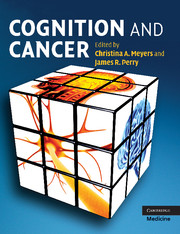Book contents
- Frontmatter
- Contents
- List of contributors
- Preface
- Section 1 Cognition and the brain: measurement, tools, and interpretation
- 1 Introduction
- 2 Clinical neuropsychology
- 3 Brain imaging investigation of chemotherapy-induced neurocognitive changes
- 4 Role of neuropsychological assessment in cancer patients
- 5 Neuropsychological assessment of adults with cancer
- 6 Neuropsychological assessment of children with cancer
- Section 2 Effects of cancer and cancer treatment on cognition
- Section 3 Interventions and implications for clinical trials
- Index
- Plate section
- References
5 - Neuropsychological assessment of adults with cancer
Published online by Cambridge University Press: 13 August 2009
- Frontmatter
- Contents
- List of contributors
- Preface
- Section 1 Cognition and the brain: measurement, tools, and interpretation
- 1 Introduction
- 2 Clinical neuropsychology
- 3 Brain imaging investigation of chemotherapy-induced neurocognitive changes
- 4 Role of neuropsychological assessment in cancer patients
- 5 Neuropsychological assessment of adults with cancer
- 6 Neuropsychological assessment of children with cancer
- Section 2 Effects of cancer and cancer treatment on cognition
- Section 3 Interventions and implications for clinical trials
- Index
- Plate section
- References
Summary
Introduction
The survival rate for patients diagnosed with some types of cancers has increased with advances in surgical techniques, radiotherapy, and the development of new chemotherapeutic agents. Although most patients continue to face aggressive multi-modality and multi-agent treatment to control or eradicate disease, cancer is not always regarded as the “terminal” disease of past decades. In fact, some types of cancer are best conceptualized as a chronic illness, more akin to diabetes, and are amenable to long-term management. It continues to be the case, however, that the majority of cancer patients will require treatment with therapies that are rarely specific to malignancy and often place normal tissues at risk. The central nervous system (CNS) appears particularly vulnerable to therapy-related changes, and there is ample evidence to suggest that many treatments are capable of producing cognitive dysfunction that can persist well after cessation of treatment. While it is easy to associate such cognitive changes to observable CNS tissue damage (e.g., post-surgical changes seen on imaging), many current treatments act at a molecular level of observation and the mechanism that links those various treatments to putative changes in a patient's cognitive functioning has not been fully elucidated. Neuropsychological assessment is well suited to quantify such cognitive impairments, which may bear directly on a person's ability to function in their environment; it also offers a methodology to evaluate the effectiveness and neurotoxic limitations of therapies at a level not typically accounted for in most clinical trials.
- Type
- Chapter
- Information
- Cognition and Cancer , pp. 44 - 55Publisher: Cambridge University PressPrint publication year: 2008
References
- 3
- Cited by



